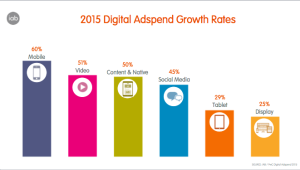
exchangewire.com
The latest IAB UK digital ad spend report found that a record £8.61bn was spent on UK digital advertising in 2015, with all aspects of digital media seeing a growth and 60% of display ad spend being traded programmatically.
The report, conducted by PwC and released on 14 April found that the number of internet-enabled devices per household increased 12%, to 8.3 per household, with a 27% rise in the ownership of connected TVs and a 21% in smartphone ownership.
The growth in digital ad spend equated to a 16.4% increase on 2014, representing the highest growth rate since 2008. Encouragingly, the growth in ad spend correlated with the growth in consumer connectedness, which means that marketers are shifting investment to where their consumers are, with mobile accounting for 78% of all growth and £2.3bn of total spend. Video and native also saw very strong growth, with the stalwart digital media of search and social continuing to thrive.

With programmatic trading now accounting for 60% of all display advertising investment, direct buys have taken a significant hit – direct now accounts for only 37% (previously 47%) of all display ads, and ad networks make up 4%.
Another study, released yesterday (18 April), by Meetrics revealed that ad viewability levels reached 54% in the first quarter of 2016; the highest level for 18 months. This, coupled with the growth in ad spend, signifies that, as marketers shift more budget into digital, the issues of viewability are coming to the forefront and more is being done to address them than ever before.
Following the recently published piece giving views from members of the IAB Display Trading Council on the fact that programmatic can now be considered as a mainstream buying mechanism,ExchangeWire asked industry leaders for their views on the results of the IAB digital ad spend report.
Brands still struggling to reach full mobile potential
“Mobile is going from strength to strength, accounting for 30.5% of all digital advertising, and yet brands are still struggling to reach the full potential of mobile and engage with the ‘always-on’ consumer. Although mobile has moved towards becoming the first screen rather than the second, it is still seen as a last-click medium, with usually disappointing results. We have found that 96% of users never click on mobile ads, even if they find them relevant. Yet our whole industry is more or less based on clicks. With more spend going into mobile, it’s time to rethink the way it is used and where it sits on the media agenda. TV and out-of-home are regarded as core parts of branding campaigns, and so advertisers must incorporate mobile in the same way. Building a brand via captivating content on mobile, targeted at the right people and time, has the potential to create a serious surge in brand awareness and engagement. In doing this, advertisers can also measure more effectively against their wider brand objectives. We all know mobile ad spend will continue to grow – but the results of that investment depend on advertisers using mobile as a medium to truly build a brand.”
Paul Carolan, Chief Commercial Officer, Widespace
People-based marketing will help mobile ad spend soar
“With more and more people accessing content on the move 24/7, many advertisers are (rightly) dedicating more budget to mobile, but are simultaneously finding it difficult to target people across all their devices. Many advertisers still have to rely on a siloed approach because they can’t tie devices to one person. The cookie-less environment of mobile leaves many advertisers guessing who they’re reaching and how often, and with most multi-channel activity clocking in and out on mobile, alongside the potential risk of ad spend wastage – it hardly touches on the true potential of what’s possible. An effective approach, in both reach and cost, is knowing who the mobile user is in order to target individuals, rather than playing a guessing game. Mobile ad spend will likely continue to soar, and by moving to people-based marketing, advertisers can tell a story on different devices and make sure that the frequency of advertising is monitored and used to the best effect.”
Katie Field, MD UK, Viant
Expect more vertical format video ads
“With more premium inventory available than ever, thanks to outstream or native video ad formats, it’s no surprise that advertisers are spending record amounts on online video. With the demise of print publications, like The Independent and El Pais, effectively monetising online audiences is now the number one priority for premium publishers. They need to find a way to deliver online advertising that works for brands, without alienating their readers. The next hurdle will be ensuring mobile video ads complement the mobile user experience, rather than disrupt it. We expect to see more and more video ads appearing in vertical formats that fit better with the way consumers are naturally using their smartphone or tablet.”
Justin Taylor, UK MD, Teads
Challenge is to find a single view
“The exponential rate that technology continues to evolve means that is an ever-increasing part of everyday life. When you then add the ability of digital media to provide a window into how people think, feel, and act, it is easy to see why digital ad spend to continues grow year-on-year. Within a complex digital landscape, the challenge for brands and marketers is to find a single view of how their customers interact across devices and channels. This is not an easy challenge but something that points to an exciting future for all marketing, and further evidence for continued growth of digital ad spend.”
James Duffy, Head of Digital, Total Media
Search investment will be maintained, as innovation continues
“It’s not surprising search has remained the dominant digital advertising category, as it often leads to the all-important final conversion click and yields high return on investment (ROI). In fact, Marin’s latest benchmark report found that search remains the channel with the highest click-through-rate. We expect advertisers will maintain investment in paid search as the big players continue to innovate in the space. Google and Bing’s Shopping campaigns, the introduction of video results, and even voice search, are all examples of exciting opportunities. However, display is quickly catching up with search, driven by mobile, which has yet again seen huge growth. As people use mobile devices more than ever to research, browse the web, check social networks, and, most importantly for advertisers, click on ads, marketers are amending their ad spend accordingly. We are now finally seeing mobile ad spend catch up with media consumption. With so many channels and devices, it’s essential marketers adopt a cross-channel advertising strategy that effectively reaches consumers on their increasing complex path-to-conversion.”
Stephanie Carr, VP EMEA, Marin Software
Brands must target mobile spend accurately
“These results show that, unsurprisingly, mobile’s rapid growth is not slowing. Our daily lives now revolve around our mobiles: from shopping, to chatting on social media, and consuming news. The opportunities for marketers to capitalise on these daily moments are clear. It’s important that while there is a surge in mobile advertising, brands target their spend accurately. With advertising bombarding consumers around the clock, it’s never been more essential for brands to react instantly and align digital campaigns with the moments that make consumers pick up their phones.”
Antoine de Kermel, MD EMEA, TVTY
Move with changes in consumer behaviour
“Increase in digital ad spend is promising to see across the industry. The latest IAB research shows that smartphones are the most popular internet device. In response to this trend, we’ve extended our InStream+ across more of our audio brands. This allows users to log-in to our radio brand apps or online. The ‘logged in and listening’ approach not only offers listeners a more targeted, personalised experience with more music and fewer ads but it gives commercial partners the chance to create and send out relevant commercial messaging to an audience they know are deeply engaged. This is a great benefit of digital, and one that media owners will be taking advantage of this year as they develop their digital advertising propositions. Whilst digital ad spend is continuing to rise, it is still important for media owners to ensure they are moving with changes in consumer behaviour and continuing to understand the best ways to reach them – be that online, print, or broadcast.”
No comments:
Post a Comment